Topics
Category
Era
International Institute of Minnesota
Christmas party at the International Institute’s first location at 584 Rice Street in St. Paul. The image was included in the 1921 annual report for the year of December 1919– December 1920. Photography by Brown’s Photo Studio, St. Paul. Used with the permission of the International Institute of Minnesota.
The International Institute in St. Paul opened on December 12, 1919. For one hundred years, it has helped meet the needs of immigrants, refugees, and asylees beginning their new lives in Minnesota.
The national Young Women’s Christian Association (YWCA) created the first International Institutes in the 1910s as service bureaus for foreign-born residents and new immigrants. Following World War I, the all-female staff and board of directors of the St. Paul Institute included Lorena Harrison, the organization’s executive secretary, and Bess Leuthold Beebe, the president of the board. The 1921 staff of four caseworkers spoke German, Italian, Norwegian, and Polish and served people from thirteen countries.
The institute’s services helped new Americans overcome barriers such as learning English, becoming citizens, and finding jobs. Caseworkers took people to appointments and made home visits. At the same time, the institute’s cultural programs helped encourage new and “old stock” Americans to share similarities and celebrate differences.
In the 1930s, the institute offered classes and programs at the downtown St. Paul YWCA and other sites. An Upper Levee site served Italians, and a West Side site served Mexicans. In 1931, Alice Lilliequist Sickels became the third executive secretary; she then began what became the Festival of Nations in 1932. A three-day “Homelands Exhibit” event that celebrated fifteen cultural groups was held at the YWCA on April 22–24 of that year.
On December 6, 1941, Japan bombed Pearl Harbor in Hawaii. In March of 1942, the US government forced West Coast residents of Japanese descent into concentration camps. In response, the institute started the St. Paul Resettlement Committee in October of 1942. Committee members found jobs and housing for Japanese Americans who wanted to leave the camps and settle in St. Paul.
During World War II, institute caseworkers responded to community needs and expanded services to work with the Red Cross to find European family members. Citizenship classes filled with resident “aliens” eager to complete their citizenship process. After the war, the institute reached out to “war brides” married to US servicemen. These women needed cultural support and English classes.
In 1946, the institute moved into its own building at 183 West Kellogg Boulevard. It built up a large membership and offered many activities to bring different cultures together. In addition to monthly international lunches and dinners with guest speakers and film screenings, it offered classes in ethnic dance, folk arts, cooking, citizenship, English, and world languages.
From 1948‒1952, the institute expanded its services to help displaced people arriving from Eastern Europe. In 1956, the Hungarian “Freedom Fighters” came after a failed revolution. In the early 1960s, the institute served Cubans fleeing their country’s Communist revolution.
The institute moved into a building at 1694 Como Avenue in 1970. After the Vietnam War ended in 1975, 3,800 people came to Minnesota from Laos, Cambodia, and Vietnam as legal refugees. In 1975, the Institute hired its first Vietnamese caseworker. By the following year, the institute’s main staff was eighteen people, and thirty teachers taught English to the new arrivals. From 1976 to 1980, the number of Hmong people living in Minnesota grew from zero to 10,000.
The Immigration Act of 1990 opened up resettlement from more countries and introduced new kinds of immigrant visas. This act guides immigration policy today and has brought an increased diversity to Minnesota. Meanwhile, the institute continued expanding services to help new Americans succeed. In 1990, it started a nursing-assistant job-training program to find better jobs for clients. In 1993, the first refugees from civil wars in Bosnia, Liberia, and Somalia came to Minnesota. The institute served 10 percent of Africans who resettled in the US in 1999.
In the 2000s, the institute served refugees fleeing conflicts all around the world. In 2001, refugee arrivals temporarily stopped after the 9/11 attacks. The institute resettled a record 2,316 people in 2004. More than half were Hmong from Wat Tham Krabok, a refugee camp at a Buddhist monastery that Thailand’s government had closed. At the same time, the institute started new programs to serve clients who needed college-readiness preparation.
As of 2019, the institute has resettled nearly 23,000 refugees and asylees to Minnesota since 1980. The institute annually serves clients from nearly 100 countries and continues to help new Americans overcome barriers to success in American life. More than fifty employees and many volunteers and interns work in the departments of Refugee Resettlement, Immigration, Employment, Job Training, English and Spanish Language Classes, College Readiness, and the Festival of Nations.
Bibliography
International Institute of Minnesota
In-house organizational archives, St. Paul
Description: Annual reports, newsletters, and scrapbooks documenting the institute’s history.
IHRC 3257
International Institute of Minnesota records
Immigration History Research Center Archives, University of Minnesota, Minneapolis
https://archives.lib.umn.edu/repositories/6/resources/4884
Description: Records (ca. 1920–1971) of the International Institute of Minnesota include minutes of the membership Council and Board of Directors (on microfilm), administrative records, educational program information, department records, materials documenting group services and activities, special programs, projects, and publications, community and national contacts, publicity, music, travel literature, case files, correspondence, photographs, and miscellany.
Keremidchieva, Zornitsa D. “From International to National Engagement and Back: The YWCA’s Communicative Techniques of Americanisation in the Aftermath of World War I.” Women’s History Review 26 (2017): 280–295.
http://works.bepress.com/zornitsa_keremidchieva/10/
Sickels, Alice. Around the World in St. Paul. Minneapolis: University of Minnesota Press, 1945.
Related Resources
Primary
St. Paul Resettlement Committee, 1942–1953
Manuscripts Collection, Minnesota Historical Society, St. Paul
https://mplus.mnpals.net/vufind/Record/001730962
Description: Correspondence, minutes, reports, clippings, records of its St. Paul Hostel (1945-1948), and other papers of this organization formed to help provide homes, work, financial aid, and social services to Japanese Americans evacuated from the Pacific Coast during World War II. After 1948 it devoted some attention to living conditions among urban Native Americans. Correspondents include Ruth Gage Colby, Ruth Tanbara, Martha Magraw, and officials of the US War Relocation Authority, the Young Women’s Christian Association (YWCA), and the International Institute of St. Paul.
Secondary
Albert, Michael. “The Japanese.” In They Chose Minnesota: A Survey of the State’s Ethnic Groups, edited by June Drenning Holmquist (558–571). St. Paul: Minnesota Historical Society Press, 1981.
Web
International Institute of Minnesota.
www.iimn.org
United States Committee for Refugees and Immigrants (USCRI). http://refugees.org/about/history
Related Images
Christmas party at the International Institute’s first location at 584 Rice Street in St. Paul. The image was included in the 1921 annual report for the year of December 1919– December 1920. Photography by Brown’s Photo Studio, St. Paul. Used with the permission of the International Institute of Minnesota.
Class photo of an English class at the International Institute. Caption from the St. Paul Pioneer Press: “Lou Ngew, left, Chin Yuk Hing, and Chin Yuk Cue are being taught reading by Miss Shirley Flatiage Institute English Instructor Oct. 3, 1938.” Photograph used with the permission of the St. Paul Pioneer Press.
Free citizenship training class at the YWCA location of the International Institute in St. Paul. Roster taken from Pioneer Press article, “Free Citizenship Training Class at Intl. Inst, July 22, 1940. Pictured are (left to right): “Samuel Yep, Mrs Sofia Chistopean, Russian; Mr. Charles Nordun, Norse; Mrs. Anna Grasse, Hungarian; Miss Margaret Wichauff, German; Mr. Albert Johnson, instructor (from WPA staff); Mr. Anton Anderson, Swedish; Mrs. Mary Katzmark, Polish; Mrs. Olga Erickson, Swedish; Mrs. Mary Orsagna, Italian; Miss Katherine Reagan, Scotland; Mrs. Rose Serratore, Italian.” Photograph used with the permission of the St. Paul Pioneer Press.
Former International Institute in St. Paul Executive Secretary, Alice Lilliequist Sickels, signing copies of her book, Around the World in St. Paul. The book detailed the history of the International Institute in St. Paul starting the Festival of Nations. The event was the Folk Arts Fair held at the International Institute located in the downtown YWCA in St. Paul. Used with the permission of the International Institute of Minnesota.
“Two members of the Overseas Brides Club practice making chicken soup with the help of a director of the Institute. It’s part of the program of making good citizens of immigrants coming to St. Paul…left to right, Mrs. J. W. Jorgenson (addresses omitted) director of the International Institute, lends a hand in cooking chicken soup for Mrs. E. G. Du Chene, while Mrs. Samuel L. Mac Kinney, reads on. Both of the brides are from France.” Photo and caption from “Home Countries Enemies, But Students Friendly,” November 8, 1947. Photograph used with the permission of the St. Paul Pioneer Press.
Small flags were given to students of the International Institute’s classes in English and American citizenship to be used on Thanksgiving. Pictured are George Semeniuk (left) from Ukraine, Elizabeth Stoerzle from Germany, Kathryn Ramsay from Finland, and Kathryn Simos, an instructor of the citizenship class. Photograph published in the St. Paul Pioneer Press on November 17, 1947. Used with the permission of the St. Paul Pioneer Press.
St. Paul International Institute Board of Directors’ President, Katherine Skiles Klein (second from right, standing). Included in this group were five immigrants going to St. Paul: Max and Helena Kurzfield (Poland), Leontine Treastas, Marija Skutans, and Johannes Theodor Raestas (Latvia). Used with the permission of the International Institute of Minnesota.
International Institute building at 183 W. Kellogg, St. Paul, 1970. This photo was taken before demolition to make way for the St. Paul Civic Center. Note the artistic rendering of a geranium in a pot on the corner of the building. The red geranium was called an “international flower” and was an important symbol to the International Institute in St. Paul. Photographer Lucy Jackson Habermann.
1979 groundbreaking for the International Institute of Minnesota Nationality Cultural Center addition. Taken outside the International Institute of Minnesota at 1694 Como Avenue in St. Paul. Institute members are dressed in traditional costumes. In the center, with the shovel, is Gretchen Quie (then-Governor Quie’s wife), International Institute Board Member Earl Bell (left), and Board Member Edward Bruno (right). Used with the permission of the International Institute of Minnesota.
Robert Hoyle (left), executive director; Jane Graupman, education director; Julie Bursik, staff attorney; John Borden, casework supervisor. Photo taken in the entryway to the International Institute of Minnesota in St. Paul. (Note: Robert Hoyle retired in 2005. John Borden was the Executive Director from 2005-2010, and Jane Graupman became executive director in 2010.) Used with the permission of the International Institute of Minnesota.
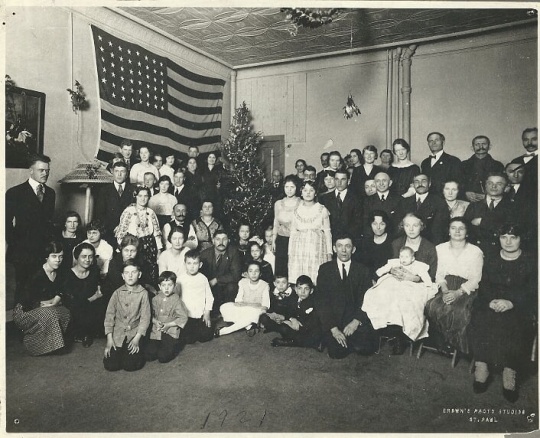
Christmas Party at the International Institute, 1920
Christmas party at the International Institute’s first location at 584 Rice Street in St. Paul. The image was included in the 1921 annual report for the year of December 1919– December 1920. Photography by Brown’s Photo Studio, St. Paul. Used with the permission of the International Institute of Minnesota.
Public domain
Holding Location
Articles
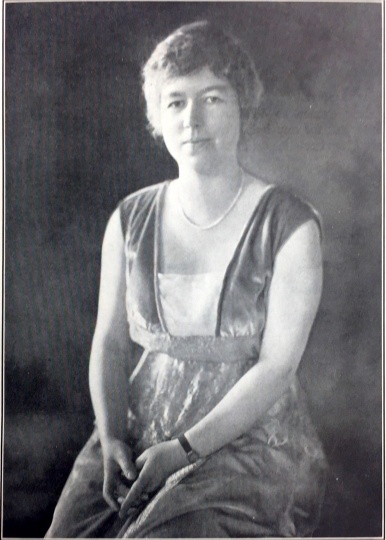
Bess Leuthold Beebe
Bess Leuthold Beebe, president of the International Institute of Minnesota’s board of directors. Taken from the institute’s 1921 annual report. Used with the permission of the International Institute of Minnesota.
Holding Location
Articles
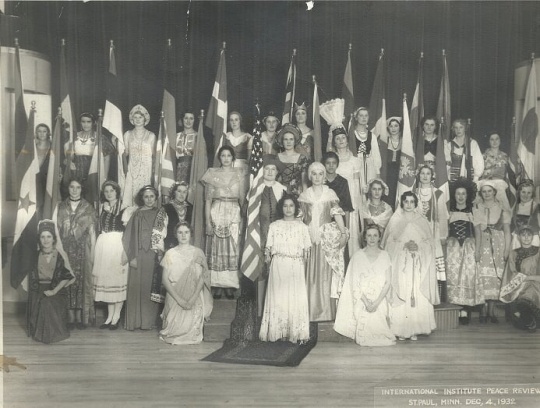
1932 Peace Review
This December 4, 1932 event called the “Peace Review” was sponsored by the International Institute and held at the downtown St. Paul YWCA at 123 West Fifth Street. Used with the permission of the International Institute of Minnesota.
Holding location: International Institute of Minnesota
Holding Location
Articles
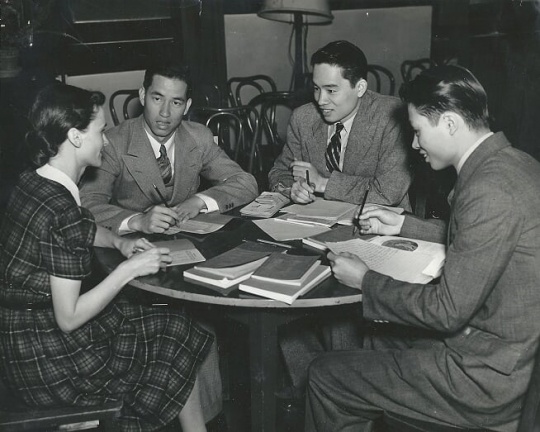
English class at the St. Paul YWCA, 1938
Class photo of an English class at the International Institute. Caption from the St. Paul Pioneer Press: “Lou Ngew, left, Chin Yuk Hing, and Chin Yuk Cue are being taught reading by Miss Shirley Flatiage Institute English Instructor Oct. 3, 1938.” Photograph used with the permission of the St. Paul Pioneer Press.
All rights reserved
Holding Location
Articles
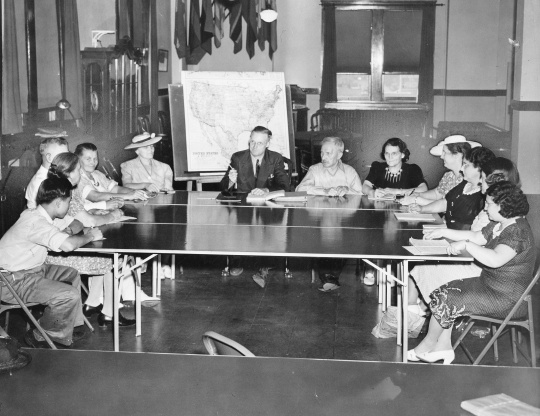
Citizenship class at the YWCA location of the International Institute, 1940
Free citizenship training class at the YWCA location of the International Institute in St. Paul. Roster taken from Pioneer Press article, “Free Citizenship Training Class at Intl. Inst, July 22, 1940. Pictured are (left to right): “Samuel Yep, Mrs Sofia Chistopean, Russian; Mr. Charles Nordun, Norse; Mrs. Anna Grasse, Hungarian; Miss Margaret Wichauff, German; Mr. Albert Johnson, instructor (from WPA staff); Mr. Anton Anderson, Swedish; Mrs. Mary Katzmark, Polish; Mrs. Olga Erickson, Swedish; Mrs. Mary Orsagna, Italian; Miss Katherine Reagan, Scotland; Mrs. Rose Serratore, Italian.” Photograph used with the permission of the St. Paul Pioneer Press.
All rights reserved
Holding Location
Articles
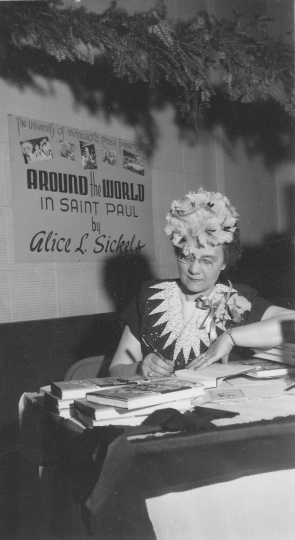
Alice Sickels book signing, December 1945.
Former International Institute in St. Paul Executive Secretary, Alice Lilliequist Sickels, signing copies of her book, Around the World in St. Paul. The book detailed the history of the International Institute in St. Paul starting the Festival of Nations. The event was the Folk Arts Fair held at the International Institute located in the downtown YWCA in St. Paul. Used with the permission of the International Institute of Minnesota.
Holding Location
Articles
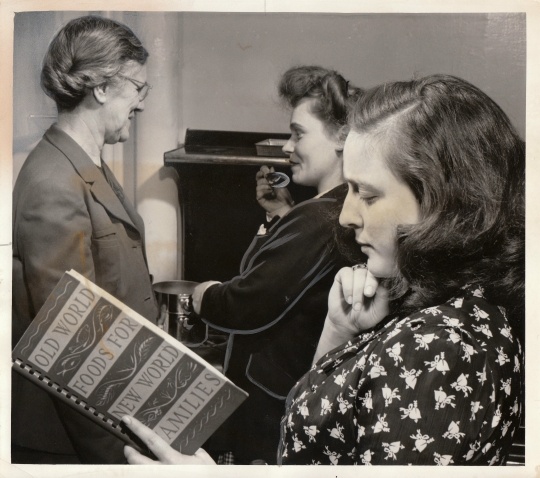
Overseas Bride Club Meeting
“Two members of the Overseas Brides Club practice making chicken soup with the help of a director of the Institute. It’s part of the program of making good citizens of immigrants coming to St. Paul…left to right, Mrs. J. W. Jorgenson (addresses omitted) director of the International Institute, lends a hand in cooking chicken soup for Mrs. E. G. Du Chene, while Mrs. Samuel L. Mac Kinney, reads on. Both of the brides are from France.” Photo and caption from “Home Countries Enemies, But Students Friendly,” November 8, 1947. Photograph used with the permission of the St. Paul Pioneer Press.
All rights reserved
Holding Location
Articles
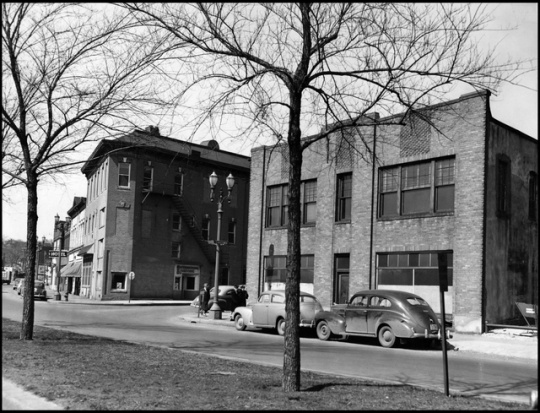
International Institute, 1949
1949 photo of the International Institute in downtown St. Paul. The building at 183 W. Kellogg is the second building from the right, at the former intersection of Kellogg and Exchange Street. The Institute moved into the building in June of 1946. This is now the site of the St. Paul RiverCentre.
Holding Location
Articles
More Information
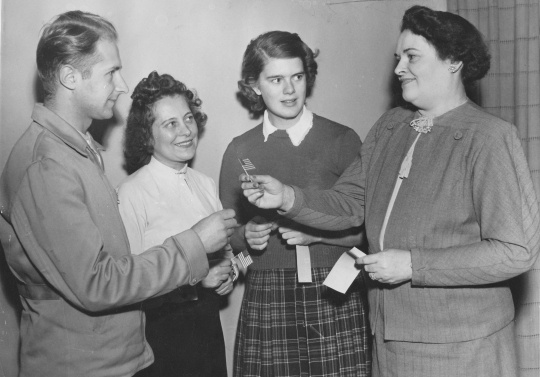
Citizenship class, 1949
Small flags were given to students of the International Institute’s classes in English and American citizenship to be used on Thanksgiving. Pictured are George Semeniuk (left) from Ukraine, Elizabeth Stoerzle from Germany, Kathryn Ramsay from Finland, and Kathryn Simos, an instructor of the citizenship class. Photograph published in the St. Paul Pioneer Press on November 17, 1947. Used with the permission of the St. Paul Pioneer Press.
Holding Location
Articles
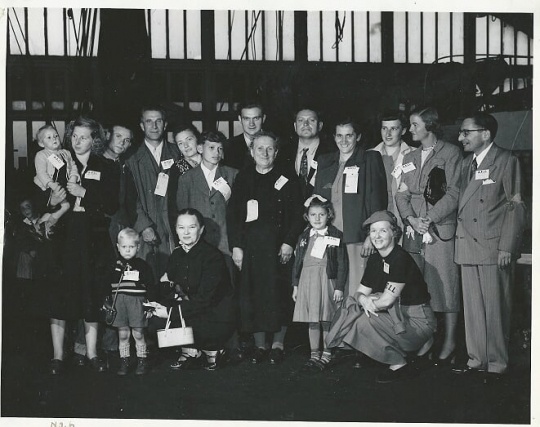
International Institute Committee welcoming refugees in New York Harbor, 1952
St. Paul International Institute Board of Directors’ President, Katherine Skiles Klein (second from right, standing). Included in this group were five immigrants going to St. Paul: Max and Helena Kurzfield (Poland), Leontine Treastas, Marija Skutans, and Johannes Theodor Raestas (Latvia). Used with the permission of the International Institute of Minnesota.
Holding Location
Articles
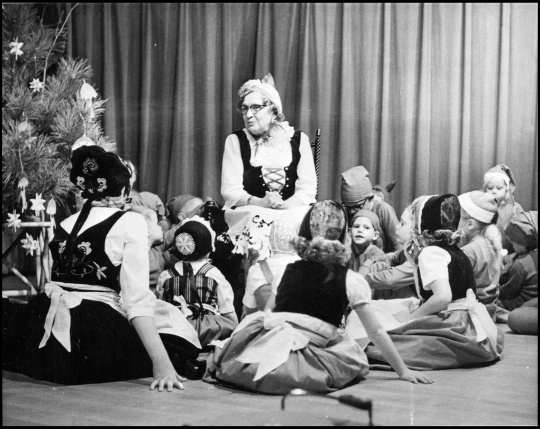
Storytelling at the International Institute
Storytelling session at the International Institute as part of a Danish folk dance party, December 11, 1959.
Holding Location
Articles
More Information
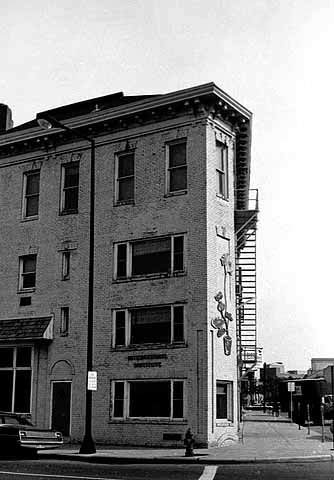
International Institute, St. Paul
International Institute building at 183 W. Kellogg, St. Paul, 1970. This photo was taken before demolition to make way for the St. Paul Civic Center. Note the artistic rendering of a geranium in a pot on the corner of the building. The red geranium was called an “international flower” and was an important symbol to the International Institute in St. Paul. Photographer Lucy Jackson Habermann.
Holding Location
More Information
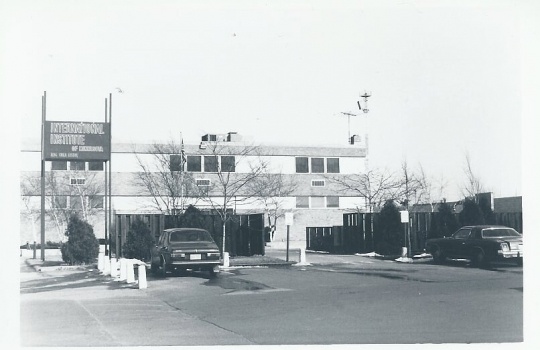
International Institute of Minnesota building, 1973
International Institute of Minnesota building at 1694 Como Avenue in St. Paul; photographed in 1973. Used with the permission of the International Institute of Minnesota.
Holding Location
Articles
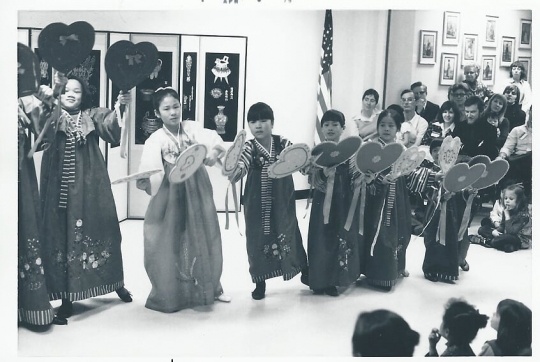
Korean party at the International Institute in St. Paul, 1975
Korean dancers at the International Institute of Minnesota, 1694 Como Avenue, St. Paul, 1975. Used with the permission of the International Institute of Minnesota.
Holding Location
Articles
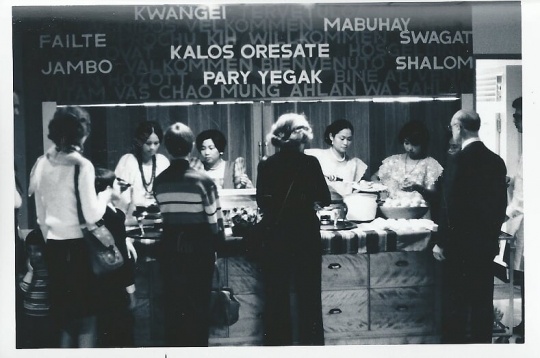
Party potluck, 1976
Party and potluck held in 1976 at the International Institute in St. Paul. Used with the permission of the International Institute of Minnesota.
Holding Location
Articles
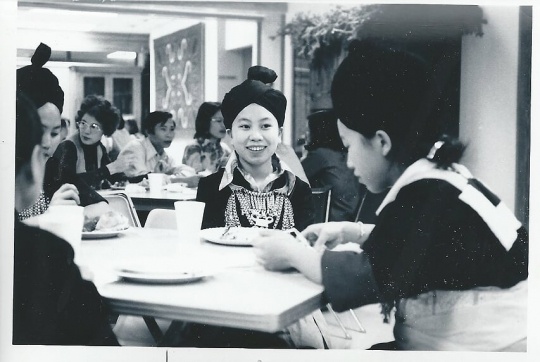
Hmong students at a party, 1976
Hmong students wearing traditional clothes at a class party and potluck, 1976. Photo taken inside the International Institute of Minnesota in St. Paul. Used with the permission of the International Institute of Minnesota.
Holding Location
Articles
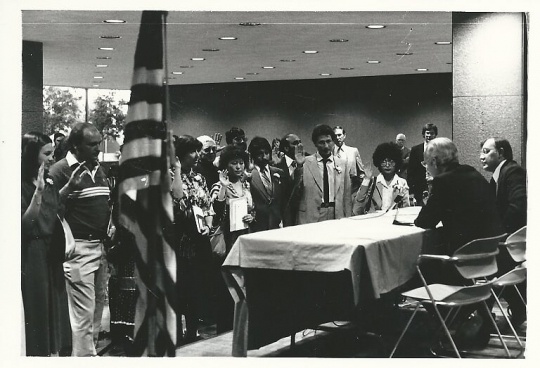
Citizenship ceremony, 1979
Citizenship ceremony, 1979. Photo taken of International Institute of Minnesota clients and citizenship students at unknown location. Used with the permission of the International Institute of Minnesota.
Holding Location
Articles
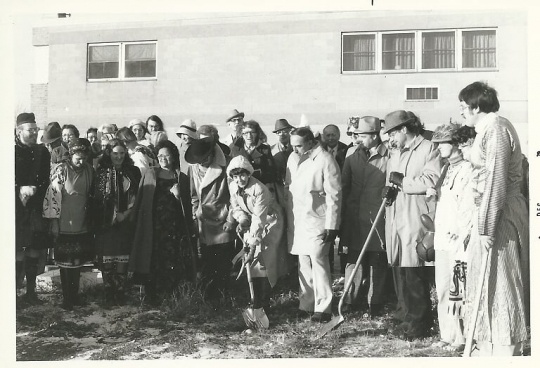
International Institute groundbreaking ceremony
1979 groundbreaking for the International Institute of Minnesota Nationality Cultural Center addition. Taken outside the International Institute of Minnesota at 1694 Como Avenue in St. Paul. Institute members are dressed in traditional costumes. In the center, with the shovel, is Gretchen Quie (then-Governor Quie’s wife), International Institute Board Member Earl Bell (left), and Board Member Edward Bruno (right). Used with the permission of the International Institute of Minnesota.
Holding Location
Articles
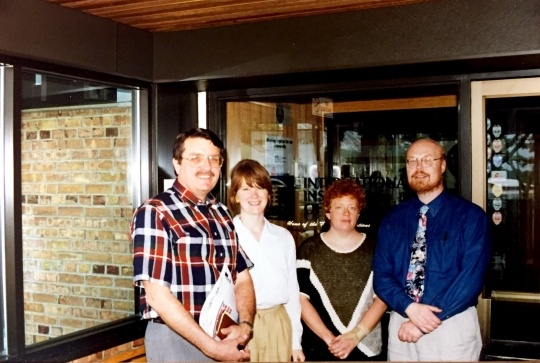
International Institute administrative staff, 1994
Robert Hoyle (left), executive director; Jane Graupman, education director; Julie Bursik, staff attorney; John Borden, casework supervisor. Photo taken in the entryway to the International Institute of Minnesota in St. Paul. (Note: Robert Hoyle retired in 2005. John Borden was the Executive Director from 2005-2010, and Jane Graupman became executive director in 2010.) Used with the permission of the International Institute of Minnesota.
Holding Location
Articles
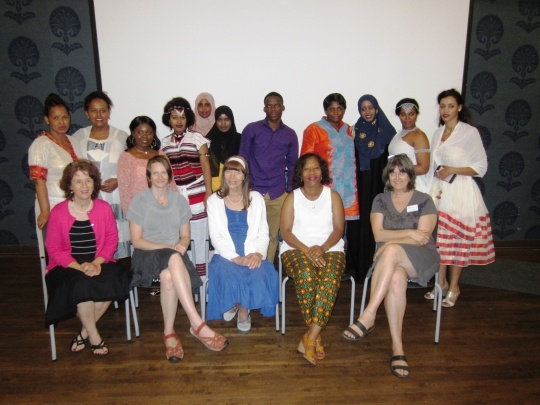
Nursing assistants’ class graduation
Nursing assistants’ class graduation party, 2018. Students standing in back. English and Nursing Instructors sitting in front. Photo taken in the Hall of Nations at the International Institute of Minnesota in St. Paul. Used with the permission of the International Institute of Minnesota.
Holding Location
Articles
Related Articles
Turning Point
In 1975, 3,800 people with the official designation of “refugee” come to Minnesota from Laos, Cambodia, and Vietnam. As a result, from 1976 to 1980 the Hmong population in Minnesota grows from zero to 10,000.
Chronology
1911
December 12, 1919
1924
April 22–24, 1932
October 26, 1938
June 1, 1946
June 30, 1970
March 9, 1972
December 22, 1976
November 1980
September 1990
1991
February 2004
October 2011
October 2013
Bibliography
International Institute of Minnesota
In-house organizational archives, St. Paul
Description: Annual reports, newsletters, and scrapbooks documenting the institute’s history.
IHRC 3257
International Institute of Minnesota records
Immigration History Research Center Archives, University of Minnesota, Minneapolis
https://archives.lib.umn.edu/repositories/6/resources/4884
Description: Records (ca. 1920–1971) of the International Institute of Minnesota include minutes of the membership Council and Board of Directors (on microfilm), administrative records, educational program information, department records, materials documenting group services and activities, special programs, projects, and publications, community and national contacts, publicity, music, travel literature, case files, correspondence, photographs, and miscellany.
Keremidchieva, Zornitsa D. “From International to National Engagement and Back: The YWCA’s Communicative Techniques of Americanisation in the Aftermath of World War I.” Women’s History Review 26 (2017): 280–295.
http://works.bepress.com/zornitsa_keremidchieva/10/
Sickels, Alice. Around the World in St. Paul. Minneapolis: University of Minnesota Press, 1945.
Related Resources
Primary
St. Paul Resettlement Committee, 1942–1953
Manuscripts Collection, Minnesota Historical Society, St. Paul
https://mplus.mnpals.net/vufind/Record/001730962
Description: Correspondence, minutes, reports, clippings, records of its St. Paul Hostel (1945-1948), and other papers of this organization formed to help provide homes, work, financial aid, and social services to Japanese Americans evacuated from the Pacific Coast during World War II. After 1948 it devoted some attention to living conditions among urban Native Americans. Correspondents include Ruth Gage Colby, Ruth Tanbara, Martha Magraw, and officials of the US War Relocation Authority, the Young Women’s Christian Association (YWCA), and the International Institute of St. Paul.
Secondary
Albert, Michael. “The Japanese.” In They Chose Minnesota: A Survey of the State’s Ethnic Groups, edited by June Drenning Holmquist (558–571). St. Paul: Minnesota Historical Society Press, 1981.
Web
International Institute of Minnesota.
www.iimn.org
United States Committee for Refugees and Immigrants (USCRI). http://refugees.org/about/history





















